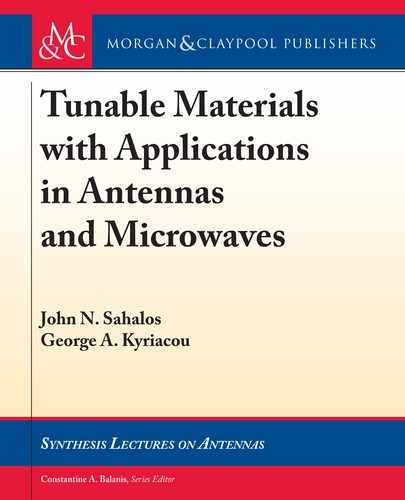
15
C H A P T E R 2
Tunable
Materials–Characteristics and
Constitutive Parameters
2.1 INTRODUCTION
Tunable materials belong to the family of modern structures that will improve engineering tech-
nology. According to WUN (Worldwide Universities Network) [
1], “In the future new materi-
als and manufacturing processes will transform our experience of everyday life. Smart structural
materials will enhance safety, comfort and fuel efficiency in transportation; new biomimetic ma-
terials may enable the replacement of organs or body tissue; new generations of display devices
will open up new possibilities in global communications and contribute to a greener environ-
ment through reduced energy consumption.” e above statement, though general, gives the
direction of the evolution of new technologies. Herein, we will focus on high frequency com-
munication technologies and, particularly, on the exploitation of tunable materials for the de-
velopment of electronically controllable radio frequency (RF) and microwave (mw) components
and devices. e advantages provided by tunable materials have already been discussed in Chap-
ter 1. It should be recalled that they serve miniaturization and integration of RF or mw front
ends into monolithic circuits and, most importantly, multi-functionality. Tunable RF and mw
devices and circuits provide us with the flexibility to adapt to various changes in operating con-
ditions. Such conditions are the operating frequency, the input impedance, and the power level
inherent in wireless communications [2]. e availability of components that can be tuned over
a broad range enables the operation of communication systems over multiple frequency bands.
Tunable materials preserve the highly desired advantages and the characteristics of frequency
selective devices. A typical wideband receiver (e.g., one based on crystal detectors) suffers from
high noise level and has poor sensitivity (always lower than about 60 dBm). On the other hand,
frequency selective receivers (e.g., heterodyne) have excellent sensitivity and low noise level as
well as low out-of-band interference. However, they are restricted to a narrowband operation.
is problem was solved by mechanically tuning their front-end frequency of operation and
by retaining a constant frequency at their intermediate stages. Modern communications and
defense systems cannot use the above technique because they require fast frequency agility (or
frequency hopping) of the order of 1 GHz/sec [3].
16 2. TUNABLE MATERIALS–CHARACTERISTICS AND CONSTITUTIVE PARAMETERS
Devices based on tunable materials can cover this demand and can offer new features
like adaptive impedance matching for amplifiers and antennas, e.g., [4]. e tuning of these
systems may be implemented via computer, microcontroller (C), and digital signal processor
(DSP) control or via a feedback loop embedded in the system. Moreover, the easily provided
power control can be used to compensate for the deleterious effects of aging and temperature
sensitivity variations of RF-mw circuits [2]. In addition, power control serves the energy-saving
requirements in mobile units.
Besides the above, the driving force behind the revolutionization of high frequency com-
munications is miniaturization of RF and mw circuits. Miniaturization is an unbreakable bond
with integration into monolithic microwave circuits (MMICs). e concept “system on chip” is
very well known and widely accepted. It has been the driving force behind the incredible revo-
lution in microelectronics as well as digital circuits and computers. Furthermore, it has already
been tested in RF electronics, where one can see exceptional advancements in mobile commu-
nications. Now, it is expected to revolutionize communications and defense systems for higher
frequencies (mw; millimeter waves). By integrating the device into a chip, we enable mass pro-
duction, which, in turn, dramatically lowers the cost, making this technology affordable for
everyone. Increased demand, especially in commercial applications, acts as feedback to technol-
ogy advancements, forming a loop with an imaginable evolution. Ferroelectric films fulfill the
need for miniaturization and integration in tunable devices. Even better performance is expected
after using ferrite/ferroelectric film structures. Artificial wire media and metamaterials also con-
stitute very promising technologies. Most of these technologies are at the stage of investigation
and evaluation.
Some of the primary alternative technologies to implement tunable RF and mw devices
are the following [2]:
1. Solid state gallium arsenide field-effect transistors (GaAs-FET) and GaAs varactor
diodes. ese tend to have low Q (quality factor) due to high losses and cannot handle
high power levels.
2. Micro-machined (MEMS)-based devices, whose reliability is still to be tested and deter-
mined. Moreover, they often have difficult biasing requirements and stringent packaging
needs.
is chapter will first focus on the microwave properties of tunable or agile materials.
ese will be discussed both in their bulk form, as thick films, and in their most desired form
for integration purposes, the thin film form. Bulk ferrites have been extensively analyzed in the
literature and a short overview will be presented. In addition, bulk ferroelectrics in conjunction
with high temperature superconductors will also be discussed.
..................Content has been hidden....................
You can't read the all page of ebook, please click here login for view all page.
